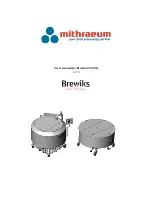
Manual 104-AIO16A and 104-AIO16E
32
Appendix B: Calibration
This board features digitally controlled potentiometers which are used to adjust the gain and offset of the
A/D function and the gain of the DAC function.
This allows both the analog inputs and outputs to be calibrated from software in the field.
In order to obtain accurate data, the proper values must be loaded into the digital potentiometers each
time the board is powered. If no constants are loaded, the potentiometers will power-on to the center of
their ranges, which will result in a non- or poorly-calibrated situation.
When the board ships from the factory it already has a valid set of calibration constants preloaded
into the EEPROM for your immediate use
.
The various calibration steps are all wrapped up in a calibration program for your use. This
program runs in DOS (and compatible environments only) and is written in Borland C/C++ 3.1 with
source code provided. You will need a DVM and a calibrated voltage source to run the program.
The following steps are only necessary if you are writing your own calibration program, e.g. for a
new operating system.
If you are unable to run the provided calibration program, it is recommended you examine its source code
for details on performing the calibration in your own code.
The rest of the chapter is broken down into several sections. First is an
overview
, a kind of “executive
summary” describing the two major steps involved in calibrating the board. Following this is a
breakdown
of the 5 calibration steps for the DAC. This breakdown is an “engineering summary” providing enough
detail that someone very familiar with the board could proceed. Then an in-depth
step-by-step
walkthrough is provided. Following this is a
breakdown
of the steps for the ADC. Finally an in-depth
step-by-step
walkthrough is provided for the ADC. Steps are numbered consistently between the
overview, breakdown, and step-by-step sections of this section so you can easily flip between them to
build an understanding of the process.
Overview: Calibrating without using the provided calibration program
This overview applies to both the DAC calibration and ADC calibration. Two parts exist to the calibration
process, and understanding these two parts is key to the entire procedure.
Step 1. Determine the calibration constants.
Step 2. Write the calibration constants into the calibration potentiometers.
Step 1 only needs to be performed if the board’s data begins to appear out-of-calibration. A good rule of
thumb is to determine new calibration constants every six to twelve months of regular use. If your
environment undergoes frequent environmental changes, more frequent calibration may be indicated.
When the board ships from the factory it already has a valid set of calibration constants preloaded
into the EEPROM for your immediate use
.
Step 2, writing the calibration constants into the digital calibration potentiometers, must occur each time
the board is powered-up (or reset). Typically, each time your program executes you’ll write these values,
even if the program was run before.








































